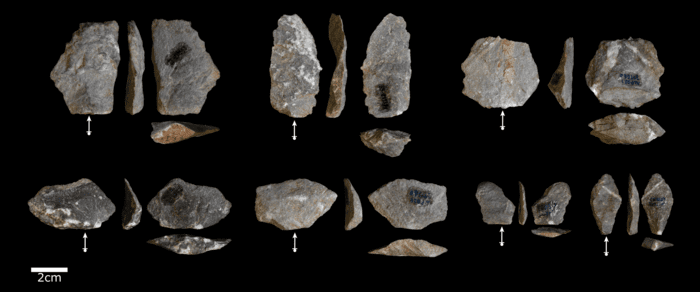Monkeys are among the many animals known to use tools, so it is no surprise long-tailed macaques in Phang Nga National Park, Thailand, crack nuts with stones. In the process these “hammerstones” sometimes break. The products look so much like the tools found in Africa and attributed to early hominins such as Australopithecus that scientists describe them as “partly indistinguishable”.
The fact many animals use tools came as a major shock to anthropologists, who had defined humans as tool-users. Wielders of stone tools are a more limited club, but even some fish qualify, and monkeys in many places find rocks handy. At least human stone tools are distinctive, broken off from larger rocks into shapes best suited to the task.
At least so we thought, until Dr Tomos Proffitt of the Max Planck Institute for Evolutionary Anthropology and co-authors had to go and put a spanner in the works – or should we say a monkey wrench? In a new study, they report that when the long-tailed macaques hit nuts with stones it can cause the stones to break, and the products can look very familiar.
“The fact that these macaques use stone tools to process nuts is not surprising, as they also use tools to gain access to various shellfish as well,” Proffitt said in a statement. “What is interesting is that, in doing so they accidently produce a substantial archaeological record of their own that is partly indistinguishable from some hominin artefacts.”

All these sharp-edged stones were made accidentally by monkeys, but they look like those considered to be carved by early hominins. Image credit: Proffitt et al, 2023
The discovery makes research into early humans harder in one way, since now any anthropologist finding such a set of broken stones needs to question which branch of the primate family made it. As the paper notes, “Intentionally produced sharp-edged stone flakes and flaked pieces are our primary evidence for the emergence of technology in our lineage.” Now that evidence will need to be re-examined, at least in some cases. “In Plio-Pleistocene contexts, the stones from Lobi Bay would likely be interpreted as evidence of intentional flake production and as the use of anvils and hammerstones for various subsistence tasks,” the paper notes.
On the other hand, this discovery could provide important insight into how humans came to be making tools like this in the first place.
“The fact that these artifacts can be produced through nut cracking has implications for the range of behaviours we associate with sharp edged flakes in the archaeological record,” said co-lead author Dr Jonathon Reeves. Stones that look like this are usually interpreted as being cutting tools. Perhaps rather than butchering animals or attacking our enemies 2001-style, the first tool crafters broke nuts with stones and then noticed how the products were well-suited to their hands.
“The identification of core and flake technology in the archaeological record has been used to infer the degree of cognitive complexity,” the paper points out. “To suggest that hominins were able to select rock types with specific material properties, understand aspects of fracture mechanics, and exhibit precision and coordination in motor skills.” Perhaps, however, we have been swayed by a desire to see these things in our ancestors.
The fact the macaques leave so many broken stones around a nut-rich site adds to the confusion. Previously the discovery of multiple flakes at one location has been considered a key identifier of early hominin tool-making.
The finding also raises questions about the macaques’ future. Last month a paper reported stone tool-making creates feedback that changes the brains of the tool-maker, indicating the adoption of tools may have accelerated the expansion of the human brain. If so, might we see a similar rise in monkey intelligence? We don’t, however, know how long the macaques have been cracking nuts this way – perhaps any brain growth is long in their past.
The study is published in Science Advances.
Source Link: Thai Monkeys’ Nut-Cracking Tools Look Confusingly Like Those Made By Early Humans